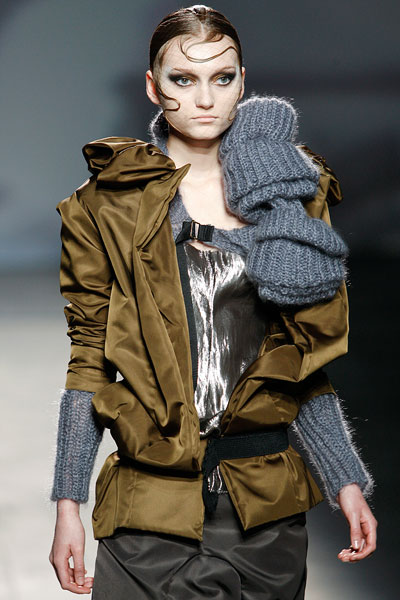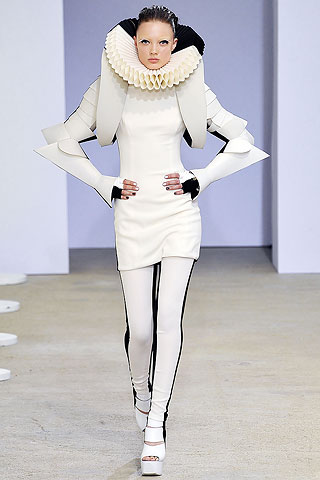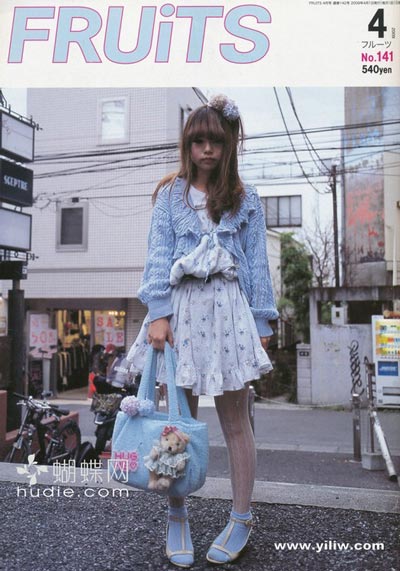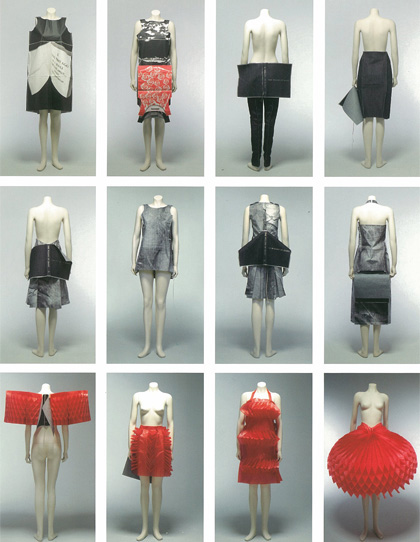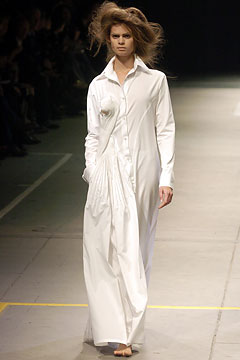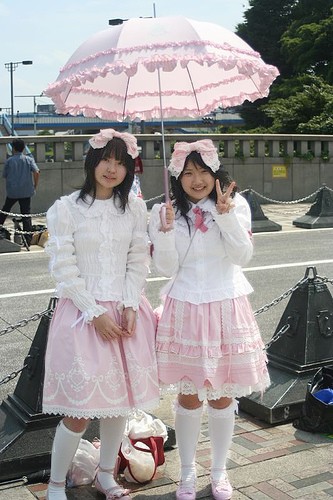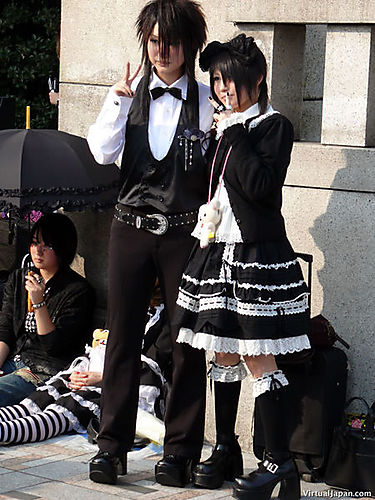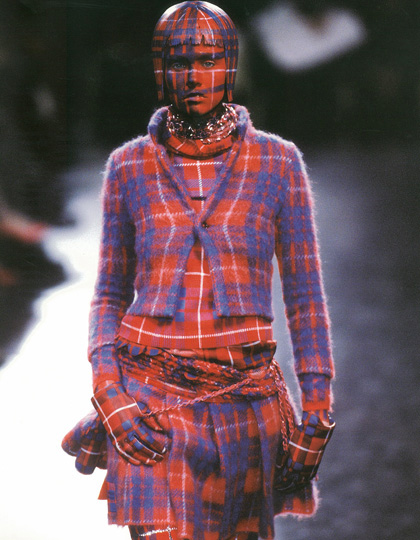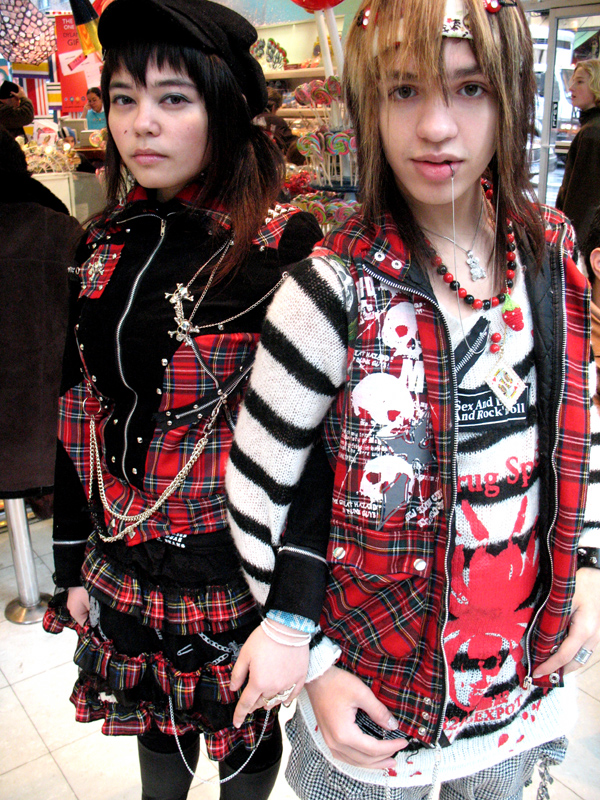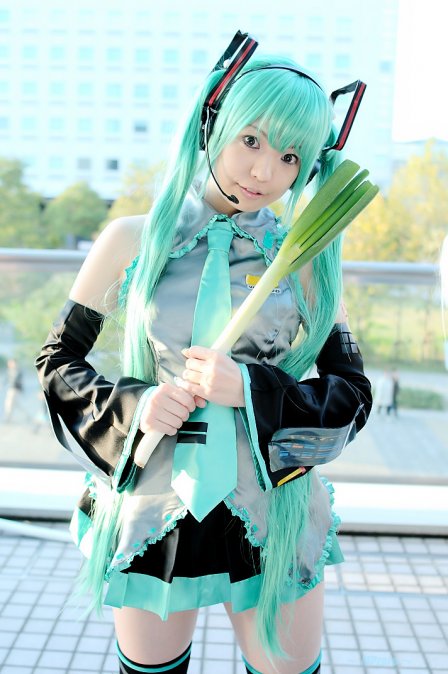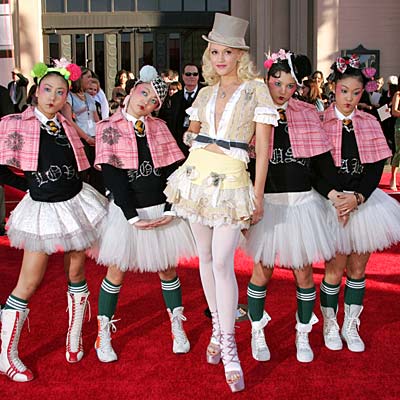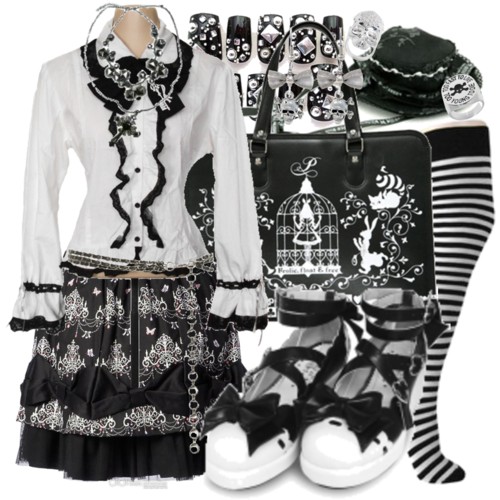Archive for August, 2011
Think Japan: Think street style (part 2)
Posted by styleinsight in World Fashion on August 22, 2011
Japanese street style is very dramatic and OTT (over-the-top), similar to haute couture and avant- garde as seen in the European countries. To view the chronicles of japanese street style refer to ‘fruits’ and ‘fresh fruits’, these one of the most famous magazines in japan where one can see innovation at its best. The fashion that we see in these magazines was a movement that grew out of those young people networking with each other, being together and being inspired by each other. The Japanese offer a truly radical fashion aesthetic, that doesn’t exist in the West. The Japanese put their money where their mouth is, and are fearless. They aren’t afraid. FUN and FEARLESS fashion is what i would call it..!
Japanese Avant Garde VS Avant Garde in the West
Japanese Avant Garde
Cover of the FRUITS Magazine
Inspiration doesn’t stop at the youth here, designers like yojhi yamamoto, comme de garçons, junya watanabe, iseey miyake have intentionally flawed japanese fashion by incorporating asymmetric drapery and exaggerated proportions with mostly a monochrome palette. Abstract, innovative, modern, architectural, asymmetric, deconstruction are a few keywords that describe the style of the various designers.
Comme De Garçons
Comme De Garçons for H&M
Junya Watanabe
For example,Issey Miyake and his A-Poc creations( it is a long piece of fabric not needing any sewing, but simply cut by the wearer without wasting any fabric and worn.) and also pleases please (polyester garments, cut and sewn then finally pleated).
Another very innovative concept was by a designer Hiroaki Ohya, who created a series 21 ‘books’ that could actually fold into abstract garments.
Yojhi Yamamoto’s development of ‘de-construction’ is the most talked about in the world of fashion. This totally provided a new way of looking at fabric, texture, cut and image. The Japanese designers strive toward theatricality, visual splendor, and organic movement.
This is where the Japanese are distinctive, they get inspired from a trend/era that people all around the world tend to follow and give it a whole new identity by adding a personal touch that makes them stand out. Who could imagine an elegant style like Victorian can be merged with gothic and rococo to achieve trendy styles like ‘gothic lolita’ and ‘sweet lolita’.
‘sweet lolita’ focuses much more on the child like aspects and uses light colours and child like fantasy themes. Alice in Wonderland, fruits, sweets and classic fairytales such as Little Red Riding Hood are a few popular ones.
Sweet Lolita & Gothic Lolita
Both these looks comprise of mini or knee-length frilly dresses with accents of crinoline and lace, corseting details and added ribbon with accessories like tiny top hats worn to one side with a lace ribbon tied under the chin, headbands or bonnets, dolls or teddy bears, parasols, frilly thigh high or knee high socks, opaque or fishnet stockings, white frilled aprons, and chokers with charms such as cameos, spiders, cherries, or skulls.
‘Gothic lolita’ which is dark and gloomy, It is characterized by crosses, spiders, bats, dark colours and gothic icons. One can actually get a taste of this style in ‘gothic and Lolita bible’ (magazine), or simply by shopping at ‘pink house’ (gothic Lolita, fashion label). And if you are in japan you can flock to the Yoyogi park in Harajuku on the weekends to experience this style in person. This style draws inspiration from the Victorian era where girls dress up to look like dolls but all done with a mysterious streak.
Then there’s the requisite punkish reference, most evident in pops of neon — be it on clothes and accessories or even streaked through the hair. Punk reminds me of a sub division of ‘Lolita’ called ‘punk Lolita’ that is inspired from the 70’s punk style in London-Vivienne Westwood, sex pistols are huge inspirations for this style. The style is different as compared to ‘punk’ all around the world; Along with original plaids and tartans, Japanese have amped it up with bright colors and extra decorative garments and accessories that the original punks could probably not have afforded. The rebelliousness is magnified with over-the-top makeup, and piercings. To experience Japanese punk style visit ‘sex pot revenge’ a shop that will provide you with all you need to act a part.
Punk all around the world: Vivienne Westwood & Sex Pistols
Japanese Punk lolita
More Punk lolita's from japan
In japan, fashion is not only a way of dressing rather it gets converted into a lifestyle like the Ganguro fashion that started as a kind of revenge against the traditional norm as to what feminine beauty should be soon became an offbeat fashion statement. Girls started dressing like American stars Naomi Campbell, Janet Jackson etc.- these gang girls wear tan makeup, dyed hair, white lipstick and eye shadow, black ink as eyeliner and false lashes.
They dress in brightly coloured clothes including miniskirts, tie-dyed sarongs, lots or rings, necklaces and bracelets. What started as a rebellion ended as a youth cult. Special magazines like the egg magazine and cawai are covering this group of teenagers and the height of the ganguro craze in japan. Ganguro culture evolved its own style of dances, know as Para Para, they dance to predetermined moves in sync to J-pop music.
Music also prompts me to narrate another popular trend in japan called ‘Visual Kei’. Visual Kei refers to a movement among Japanese rock musicians and is characterized by the use of elaborate costumes, eccentric looks and hairstyles.
‘visual kei’ also gave way to ‘cosplay’ that started when fans started dressing up like their favorite band members. The ‘cosplay’ style of dressing extended on to anime and manga lovers. These Followers of Japanese comics and animation decided they enjoy dressing up as their favorite characters, and so it became a trend. Just like the rest of the world dresses up on Halloween, japan does it more excitingly at public events, gathering, shows and parties at various cosplay cafes.
The Japanese pop culture street fashion is creating a style that is an inspiration for Designers and celebrities – from Gwen Stefani to Jay-Z and Kanye West.
Gwen Stefani and Harajuku Girls
Kanye West for 'The Bathing Bape' a japanese clothing brand
For example, gwen stafani and her harajuku girls. Her album (harajuku lovers), later her clothing collection and accessories are an inspiration from japan and its fashion sub cultures. Even Americas next top model (cycle3) had a task where the models had to dress up like Japanese harajuku girls, the trick is here is not to try too hard, just observe and try to get the essence.
Gwen Stefani & harajuku girls: 'Harajuku Lovers' perfume
Americas Next Top Model: Cycle 3: Japan Fashion Task
To learn more, just try layering, mix and match, DIY techniques, asymmetry and along with that online shopping offered by various Japanese stores can be a way to experiment with the look. one can easily be accessible to Japanese fashion and by mixing it with your statement pieces, you can give it a whole new look.
Look boards: Inspiration for japanese fashion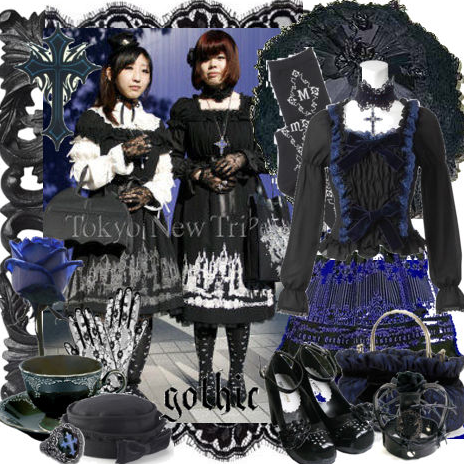
Here are a few look boards that you can learn from, Soo keep experimenting and creating something fabulous,
innovative and out-of –the –box.
Get Inspired: Japanese Street style
Posted by styleinsight in How to wear, World Fashion on August 7, 2011
Around the world, designers, stylists and magazines dictate fashion but there is a place, where these important people act only as catalysts to the fashion scenario.
The destination being JAPAN, where fashion is purely led by the youth and by what they wear.
Be UNIQUE, Stand OUT, Make NOISE, and be YOURSELF… being their motto.
The only place where the youth sells fashion and act as stylists and marketers. The trendy fashion conscious teenagers who are admired for their style work as salesgirls to promote brands and their own style statement and sometimes they even end up designing for these stores. Without any formal degree in design and fashion these teenagers must surely be really talented.
Shoppers and Stylists at shops in Harajuku
According to me, fashion in Japan is quite pictographic; there is so much symbolism, expression and rebellion. What’s more unique is the fact that there are magazines for everything, from fashion in various districts to manga and anime, magazines for working women in various age groups to magazines for hairstylists and makeup artists and even for various fashion cultures and their sub cultures.
Biteki-working women: 20-30 years:Brand Joy-Info,well established brands:Curl- beauty & hair
Cazi Cazi-street fashion in kansai area:Choki Choki-hairstyle for men : Cosmode-Cosplay Mag
Japanese fashion to a layman might just be about kimono’s and the wooden geta sandals or the obi belt but what we don’t know is that it’s big on the street fashion scene. Street fashion as a category started from japan and ventured into different parts of the world. In the 1990’s,Youngsters on the streets of japan in shibuya and harajuku areas of tokyo marked a change in the way the youth were dressing. Out of all the same old uniform styles, an identity crises for individualism came about and the youth didn’t want to wear the clothes that everyone was wearing just because they were branded or in vogue. Therefore, they customized outfits by adopting a mixture of traditional and international current trends. The unique part of this street style being that these clothes were that they not available in any store rather they are suited to the wearer’s creativity and style. Therefore, each style and trend got divided into various sub categories as per the wearers experimenting capability. Like Lolita fashion was divided into ‘punk lolita’, ‘gothic lolita’, ‘sweet lolita’ and so on.
customized, self crafted fashion
Even now such fashion is generally combined with handmade, secondhand and alternative designer fashion in an innovative ‘DIY’ (do-it-yourself) approach to dressing.
Do-It-Yourself Style
In general the Japanese street style is eclectic. The Tokyoites would wear prints, plaids, leopard spots, ruffles, lace and Fair Isle knits, all topped with voluminous scarves, lots of fur trimmings or lots of accessories. The quirkier the better is their catch phrase, from clothes to headgears: with looks ranging from oversize earmuffs to a miniature pillbox or ‘kawaii’ hairbands and clips.
Eclectic Layering with volume, plaids, color,prints and texture
Talking about ‘kawaii’ let me describe this in more detail, Kawaii means “cute” or “pretty this plays an important role in Japanese culture, entertainment, food, clothing, toys, fashion and behavior. Kawaii fashion generally relates to someone wearing clothing that appears to be made for young children or clothes that accentuates the cuteness of the individual wearing the clothing.
'Kawaii' Fashion
For example, the ‘hello kitty’ that is really popular on clothing and accessories, be it teenage girls or adult women, this ‘kawaii’ character is seen all over the streets. It’s a bit like the short-lived ’80s nostalgia fad that hit North America recently, when girls were sporting My Little Pony and Strawberry Shortcake t-shirts.
To accentuate this style, one can take the help of the ‘decora’ trend. Lots of layering and colorful accessories define decora. The accessories include plastic and furry toys and jewelry and more jewelry and more jewelry. The more the better is the key!
'Decora' Fashion
This is not the end to sweet things in japan, lets not forget the ‘fairy kei’ and ‘dolly kei’. There are lots of combinations of the pastel colors, or pink and red, pink and white and pink and black, with pink being the most abundant. Fairy style is being supported by an adult woman who prefers lovely items. The pioneer of fairy style is fashion producer Sebastian Masudea who opened the fairy cloth shop “6% DOKI DOKI” in 1996. He is coordinating everything by himself from the make up of shop clerks to exterior and interior according to his themes, which are “sensational and lovely”, “not only cute but also happy” and “feeling of unreality”.
'Fairy Kei' Fashion: A Photoshoot
6% Doki Doki: The famous Fairy Kei Store
Doki Doki: on Seattle Tv : From their travels of 2011
‘Dolly kei’ on the other hand,is one of Japan’s newer styles but unlike some of their trends its very earthy.It has a feel of medieval Celt and Russia, folksy garments which are antique centric.It takes inspiration from antique (and slightly spooky) dolls and movies such as Narnia, Alice in Wonderland and Harry Potter.Its full of florals, furs and dark colours. Its cute in a fairy-tale kind of way reminiscent of a Russian doll.This style began when now infamous shop ‘Grimoire’ was opened.The Japanese are a well-known nature focused nation with Shinto and a belief in spirits therefore,this style combines the gothic side of loligoth with the nature vibe of mori kei (forest girl).
Shop: Grimoire in shibuya,Tokyo
With all this and so much more, japan is a destination for inspiration and an amazing pool of art and craft. If this has excited you, there is more coming about in my next blog…soo keep reading know more about japan and its fashion and its subcultures..!
